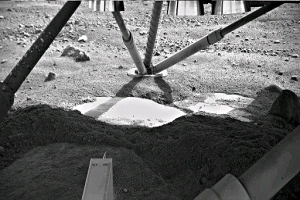Two blogs ago I wrote about the then upcoming landing of the Phoenix spacecraft on Mars, near the Northern polar ice cap (Probing the Martian Pole). The entire point of landing on Mars' extreme northern plains was to find and examine ice-ice we know is up there in great abundance, as detected by orbiting spacecraft (Mars Odyssey 2001).
There, frozen under the surface dust layers, is a vast deposit of ice-"enough to fill Lake Michigan twice." So Phoenix was sent to actually land there and scrape up surface samples of the soil, and hopefully ice. The question was, would the layer of dust covering the ice be thin enough for Phoenix to reach the ice with its robotic arm and shovel?
The landing occurred on May 25th-a successful landing. NASA broadcast the drama live on NASA TV, which we shared with several hundred Chabot visitors via planetarium, theater, and closed-circuit TV. There were no actual images coming from Phoenix during the landing-after all, it was cooped up in its protective shell for much of the descent-but the excitement of the real-time drama and the nervous faces of NASA/JPL were enough to enthrall our audience. Pictures wouldn't come form Phoenix until later that night at the earliest.
But the pictures did come in over the days following. At first they looked much like images from other Mars landers (Viking, Pathfinder, Spirit, Opportunity), only flatter. Rusty red soil, low flat horizon, a scattering of pebbles and rocks. The landscape itself appeared less interesting to me than other landing sites-but if you measure Phoenix's success by the beauty of the scenery, you're missing the point.
Phoenix is pretty much all about the ice, and what chemicals are frozen and preserved in it. The questions asked by the Phoenix mission are: did life ever arise on Mars, is the current climate on Mars suitable to support life, and what is Mars' geological makeup? If the vast ice deposits of the flat northern hemisphere lowlands are the frozen leftovers of what was once a liquid sea, then are there chemical clues of past conditions-even past life-locked up and preserved there?
